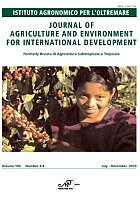Abstract
This study examined constraints militating against the profitability potentials of snail (Archachatina marginata) production by small-scale snail farmers in Cross River State, Nigeria. Data were obtained from a random sample of 120 respondents in the study area by means of structured and semi-structured questionnaire. The first stage involved random selection of three (Ogoja, Ikom and Odukpani) local government areas from eighteen local government areas in Cross River State, Nigeria. This was followed by random selection of three villages (Igoli in Ogoja Local Government Area, Alesi in Ikom Local Government Area and Adiabo in Odukpani Local Government Area) in Cross River State. The respondents were randomly selected from each of the villages, 40 respondents were selected each from three villages, making a total number of 120 respondents. Data collected were analyzed using descriptive statistics and costs returns analysis. The results indicated that Cobb-Douglas production function had the best fit in explaining the relationship between output of snail and inputs used, the coefficient of multiple determinant (R2=0.60 indicates that sixty percent of the variability in output of snail is explained by the independent variables). Results from the analysis revealed that the marginal value products of farm size, labour, farm management practices and operating costs were N1080, N20.6, N972.8, N14.84 respectively, there existed allocative inefficiency, there is a high potential for snail farmers to increase their yields and income.
Further analysis of results revealed that net returns on snail is N2,935,000.00 with return on every naira invested of N0.14 is also positive indicating a profit from the business, with attractive net return on investment. This study shows that snail farmers are faced with several problems in their production activities. These problems or constraints affect the efficiency of snail production in the study area. Notable among them are high cost of feed supplement, lack of capital, inaccessibility of formal credit source because lack of collaterals, lack of extension agents, lack of medication/vaccines, poor production infrastructures and lack of good farm management practices occupied 15%, 14.17%,11.67%,10%,9.17%,9.17% and 8.33% respectively. The constraints associated with the business as highlighted in this paper if tackled could pave a way to increase profit and this will alleviate poverty in Cross River State. Hence, forefficient production of snail in the study area, these constraints must be drastically reduced to the barest minimum. This can be done through efficient policy formulation and implementation, proper supervision of snail production programme, effective extension services and proper agricultural financing. Snail farmers in the study area should be train by extension agents on how to control some of constraints that militate against the profitability potential of snail production. Beside that snail farmers should form cooperative group (s) in order to obtain loans from bank (s) to increase their capital base for higher output.





